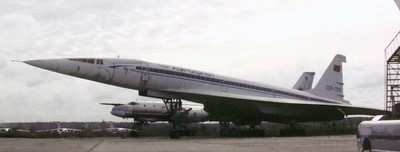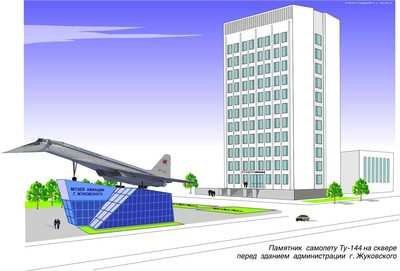What's The Scrap Value Of An SST?
by Aero-News Senior Correspondent Kevin R.C. "Hognose"
O'Brien
It was loud, it was fast, it was first. It was the Tupolev
Tu-144 supersonic transport, a Soviet-era Russian design that made
Concorde look rationally profitable -- if only by comparison.

The last and lowest-time of the airworthy rare jets has just
been saved from the fate of so many historic aircraft -- a one way
ride to the smelter. Thanks to Russian enthusiasts, the
question posed by this article: "What's the scrap value of an
SST?" may, after all, go unanswered.
The plane in question is Tu-144D serial number 09-1,
registration CCCP-77115, or "115" to fans of the program. It was
the last of 16 airworthy Tu-144s built. Its first flight was in
1984 -- long after the cancellation of scheduled Tu-144 supersonic
service in 1978 -- and it has only 32 hours on the airframe and
RD-36 engines. (Another source says 115 has 86 hours. A final
example, 09-2, never flew and is still at the Voronezh Aircraft
Factory, presumably racking up staggering tie-down fees).
 No two Tu-144s were
exactly the same, as the 16 airworthy planes were of nine different
series and all were largely handbuilt. Most of the differences are
found in the engine pods and the intakes -- as any jet designer
will tell you, art, science and lots of patience go into intake
design, which is critical to performance in every corner of the
flight envelope.
No two Tu-144s were
exactly the same, as the 16 airworthy planes were of nine different
series and all were largely handbuilt. Most of the differences are
found in the engine pods and the intakes -- as any jet designer
will tell you, art, science and lots of patience go into intake
design, which is critical to performance in every corner of the
flight envelope.
The supersonic jet was sometimes called "Concordeski" by Western
detractors, who alleged it was a copy of the elegant Franco-British
SST, but the Tu-144 prototype actually flew two months before
Concorde, and the similarities come more from the two types'
similarity of mission. The Tu-144 has a more angular planform, a
larger fuselage, high-aspect-ratio canards (which were retrofitted
after the original displayed atrocious low-speed handling), and
numerous other differences from Concorde.

Before the intended production series got underway, there was
one flying prototype and one pre-production machine, which broke up
inflight in 1973 at the Paris Air Show when the crew apparently
overstressed it trying to recover from an inadvertent spin.
After an abortive attempt at flying the Moscow-Delhi route, the
aircraft were re-oriented to fly mail and some pax from Moscow to
Alma Ata, Kazakhstan and return.
Passengers remember the Tu-144 as unimaginably
loud... but unlike Concorde, it wasn't expensive to fly
during its Moscow to Alma Ata days -- the ruble equivalent of about
$65 would do it.

In 1993, two Tu-144s were inspected and overhauled for a joint
Russian/US flight research program. The research aircraft was known
as the Tu-144LL and the last two production Tu-144s, 114 and 115,
were set aside for this program. As it happened, 114 was used -- it
became the only Tu-144 to wear a Russian "RA-" in place of the
obsolete Soviet "CCCP-" registration -- and 115 was carefully
pickled in backup storage. After NASA canceled the program due to
budget priorities in 1999, 114 was parked on the ramp at Tupolev's
flight research center and let to deteriorate (it had a whopping 82
hours on it).
If anyone ever wanted to bring one to airworthiness, 115 would
probably be the one. But for a while it didn't look like the plane
would survive at all. Several attempts to sell the planes as
planes, or as museum pieces, fell through, and in the end a scrap
dealer bought them in March, 2006.
Enter the Heroes Club of Zhukovsky, a group of Russians from
that city that have been awarded the very honor Hero of the Russian
Federation or its predecessor, Hero of the Soviet Union. In
Zhukovsky, many of them are flight-test or aircraft-development
veterans; others are cosmonauts and war heroes. They have been
raising funds to restore the faded paint, and preserve the physical
aircraft, as a memorial to the test pilots and flight test
engineers who were responsible for so much Russian technological
advance. Zhukovsky, near Moscow, is the Russian equivalent for the
US's military and civilian flight test centers in one, and is the
scene of hundreds of desperate saves and tragic crashes, thousands
of daring flights and technical breakthroughs, and hundreds of
stories, many of which remain untold to the public.

Even today, the Gromov Flight Research Institute operates at
Zhukovsky.
The Heroes are collecting funds on their website which is this
story's FMI link (note that it's in Russian. A functional Russian
to English web-based translation program is here.) Right now, they seem to be set
up only to collect from folks in their part of the world. (Maybe
SETP could partner with the Heroes of Zhukovsky?)
Meanwhile, faced with a barrage of negative public opinion, the
scrap dealer decided that they would just as soon scrap other stuff
than historic aircraft, and they cut a deal with the Heroes at the
end of May.
The aircraft will certainly be on public display, but the
location is not final yet. One possibility is on a piece of the
Gromov Institute, which the Institute would donate. The airplane
would be put on pylons to keep it out of the reach of vandals. The
other possibility is a breathtaking installation atop a glass
museum entrance in Gromov Square in downtown Zhukovsky -- right in
front of the new city hall (see rendering above).
While the Russians are grateful to have saved this jet from the
knacker's yard for a lifetime of static display, a British
organization is trying to arrange for a Concorde to fly again.
While, given the way British Airways has preserved two airframes,
this is technically feasible, it is likely that it will be
practically impossible -- as is the case with 115.

While Concordes were shipped to several museums around the
world, all Tu-144s but one remain within the footprint of the
former Soviet Union that created them. The exception is 77112
(Serial 07-1) which is in Sinsheim, Germany, where it's displayed
on a plinth next to a Concorde, showing the intriguing similarities
and differences between the two supersonic transports. The machines
once intended as serious, profitable airliners wound up instead
being money-burning prestige leaders, and now they artifacts that
speak to us about a past that some of us lived in, and some can
only try to imagine.
 ANN's Daily Aero-Linx (04.16.24)
ANN's Daily Aero-Linx (04.16.24) Aero-News: Quote of the Day (04.16.24)
Aero-News: Quote of the Day (04.16.24) Airborne 04.10.24: SnF24!, A50 Heritage Reveal, HeliCycle!, Montaer MC-01
Airborne 04.10.24: SnF24!, A50 Heritage Reveal, HeliCycle!, Montaer MC-01 Airborne 04.12.24: SnF24!, G100UL Is Here, Holy Micro, Plane Tags
Airborne 04.12.24: SnF24!, G100UL Is Here, Holy Micro, Plane Tags Airborne-Flight Training 04.17.24: Feds Need Controllers, Spirit Delay, Redbird
Airborne-Flight Training 04.17.24: Feds Need Controllers, Spirit Delay, Redbird








